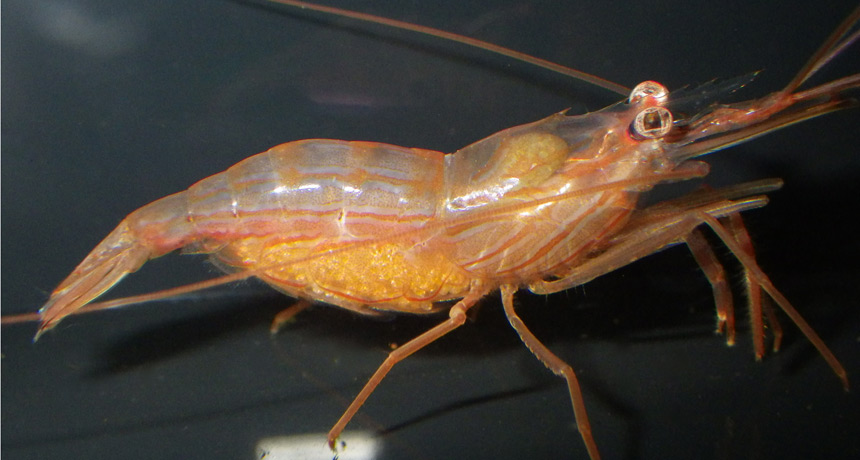Ocean of the future may make shrimp small and colorful
Teen shows that ocean acidification may make shrimp easier for predators to see

This peppermint shrimp (Lysmata wurdemanni) is already a cheerful orange. A teen showed that a more acidic ocean environment could intensify that color.
Andrew Bogott/Wikimedia Commons (CC BY-SA 4.0)
WASHINGTON, D.C. — Many ocean lovers, such as Olivia Lazorik, 15, know that something big is happening to the world’s oceans. As human activities produce more and more carbon dioxide, the ocean takes up more and more. And this extra CO2 is making the ocean slightly more acidic. It’s not enough to eat the skin off your bones, like in some horror movie. But it can affect the creatures that live in the ocean, sometimes in unexpected ways. Olivia showed that the ocean of the future may produce smaller, but more colorful, shrimp. Her findings won her second place in mathematics at the Broadcom MASTERS competition last week.
Olivia, now in ninth grade at St. Edward’s School in Vero Beach, Fla., was one of 30 finalists in the 2016 Broadcom MASTERS. MASTERS stands for Math, Applied Science, Technology and Engineering for Rising Stars. This yearly competition brings middle-school science fair winners together from around the country to compete in team projects. It was created by Society for Science & the Public and is sponsored by the Broadcom Foundation. (Society for Science & the Public publishes Science News for Students and this blog.)
An acid — such as lemon juice — is a substance that reacts with a base — such as lye — to form a salt. Scientists measure how acidic or basic a liquid is using the pH scale. Acids have a pH of between 0 and 7, while bases have a pH between 7 and 14. Distilled water on its own is neutral; it’s got a pH of 7. The ocean has much more than water, though — it also contains salt, minerals and other chemicals. It’s a bit basic, around a pH of 8.1
The burning of fossil fuels such as oil or coal produces carbon dioxide. When some of that CO2 dissolves into the ocean, it reacts with water and the chemical calcium carbonate to form bicarbonates. This makes the water more acidic. By the year 2100, ocean pH could be as low as 7.5.
That’s bad news for shelled animals such as clams, which rely on calcium carbonate for their shells. Shrimp also have a hard exterior (it’s the bit you peel off before you eat them). It’s called an exoskeleton. But shrimp, it turns out, aren’t like clams. Shrimp respond to a lower pH by sucking up more calcium for their exoskeletons. So a lower pH, Olivia explains, may produce shrimp with more calcified exoskeletons.
What might that mean for shrimp inside? To find out, Olivia took home 12 aquarium tanks from the Vero Beach Marine Laboratory at the Florida Institute of Technology. The teen placed the tanks on her home’s porch and divided them into two groups. The first six tanks got three peppermint shrimp (Lysmata wurdemanni) each and were filled with water at a pH of 8.1. The second six tanks got another three shrimp each and were filled with water at the pH of the future — 7.5.

Before slipping the shrimp into the tanks, Olivia weighed them and took pictures. She analyzed the pictures with a computer program to determine the length of each shrimp and the intensity of its coloring. She added the same amount of food to each tank every day for 24 days and then weighed and measured the shrimp again.
After 24 days in water with a pH of 7.5, the peppermint shrimp weighed less than the shrimp in the control condition, water with a pH of 8.1, Olivia found. But while the shrimp were lighter in weight, they were also more intensely colored.
“I conclude that in the future environment the shrimp [may be] adversely affected as they do not grow as much,” she says. Olivia is also worried about the change in color, since that may affect how predators see the shrimp.
Olivia is not alone in her findings. One of the most important aspects of science is replication — when several scientists perform similar experiments and find similar results. Jennifer Taylor of the Scripps Institute of Oceanography in La Jolla, Calif., and colleagues found that another type of shrimp, when exposed to a pH of 7.5 for 21 days, also ended up more colorful than their controls. These scientists published their findings last year in the journal Scientific Reports. These more intensely colored shrimp, they noted, may not be able to hide as well from predators — making them more likely to end up as someone’s dinner.
Follow Eureka! Lab on Twitter







